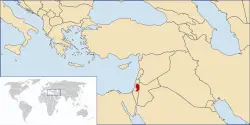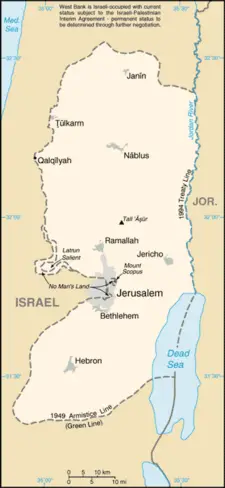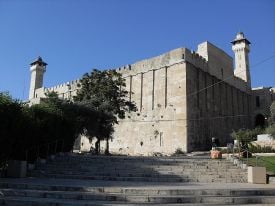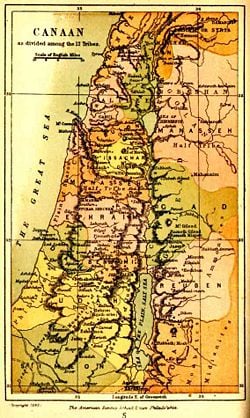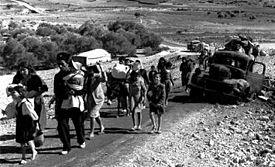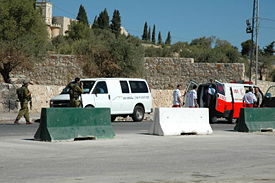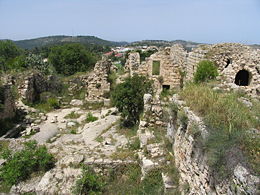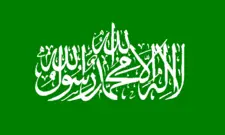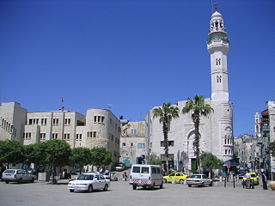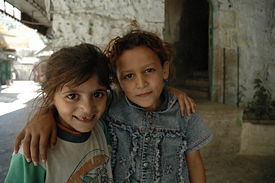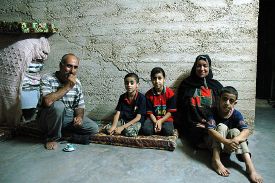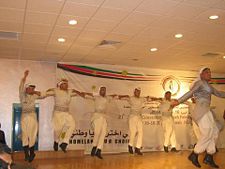West Bank
| اÙسÙطة اÙÙØ·ÙÙØ© اÙÙÙسطÙÙÙØ© As-Sulta Al-Wataniyya Al-FilastÄ«niyya Palestinian National Authority | |||||
| |||||
| Anthem: Biladi | |||||
| Capital | Ramallah and Gaza de facto, as the current location of government institutions. [1] 31°54â²N 35°12â²E East Jerusalem[2] is the desired capital of an independent Palestine. 31°46â²N 35°15â²E | ||||
|---|---|---|---|---|---|
| Largest city | Gaza [3] | ||||
| Official languages | Arabic | ||||
| Government | Palestinian National Authority | ||||
| Â - President | Mahmoud Abbas (Fatah) | ||||
| Â - Prime Minister | Ismail Haniya (Hamas) | ||||
| Constitution | created in 2003Â | ||||
| Â - Independence | Â | ||||
| Â - Declared | November 15 1988Â | ||||
|  - Status | Occupied territory | ||||
| Area | |||||
|  - Total | 6,220 km² (169th) 2,402 sq mi | ||||
| Â - Water (%) | 3.54 | ||||
| Population | |||||
| Â - 2005 estimate | 2,632,000 | ||||
|  - Density | 446.1 per sq. km./km² 1159.5 per sq. mi./sq mi | ||||
| GDP (PPP) | 2005 estimate | ||||
| Â - Total | $5.327 billion | ||||
| Â - Per capita | $1,500[4] | ||||
| HDIÂ Â (2006) | |||||
| Currency | Israeli new sheqel Jordanian dinara ( JOD, ILS)
| ||||
| Time zone | Â (UTC+2) | ||||
|  - Summer (DST) |  (UTC+3) | ||||
| Internet TLD | .ps | ||||
| Calling code | +970b | ||||
| a West Bank only. b Not officially assigned. | |||||
The West Bank (Arabic: اÙضÙØ© اÙغربÙØ©, Hebrew: ×××× ××ער××ת, Hagadah Hamaaravit), also known as Judea and Samaria, is a landlocked territory on the west bank of the Jordan River in the Middle East.
The area is regarded by many Jews as the birthplace of the Jewish peoples and is the location of the main Jewish religious sites and tombs. The territory was the homeland to Palestinians until the 1948 Israel-Arab war of independence. It is governed by the Palestinian National Authority (initially set-up as an interim government), but is considered by many, including the United Nations, to be an Israeli-occupied territory. The State of Israel began building a barrier of fences, trenches and walls around the territory in 2003. Movement of both Israelis and Palestinians in and out of this territory is seriously restricted. One result of such restriction is severe poverty, as the means of both job-security and tourist income has been lost.
The key challenge facing the Palestinian National Authority is to build a genuine indigenous national unity that would transcend sectarian loyalties. Based on that unity, economic development could proceed.
Geography
The name "West Bank" was apparently first used by Jordanians at the time of their annexation of the region, has become the most common name used in English, and describes territory on the west bank of the river Jordan Riverâthe Kingdom of Jordan being on the east bank of the same river.
Israelis refer to the region either as "The West Bank or as Judea (Hebrew: "Yehuda" "×××××") and Samaria (Hebrew: "Shomron" "ש××ר××"), after the two biblical kingdoms (the southern Kingdom of Judah and the northern Kingdom of Israelâthe capital of which was, for a time, in the town of Samaria). The border between Judea and Samaria is a belt of territory immediately north of (and historically traditionally including) Jerusalem sometimes called the "land of Benjamin." The name Judea and Samaria has been in continual use by Jews as well as various others since biblical times.
Bordering Jordan to the east and Israel in all other directions, the West Bank is a landlocked territory that has a total area of 2262 square miles (5860 square kilometers), slightly smaller than the U.S. state of Delaware. The terrain is mostly rugged dissected upland, some vegetation in west, but barren in east. It is mostly composed of north-southâoriented limestone hills, called the Samarian Hills north of Jerusalem and the hills of Judea to the south, with a height of 2300 to 3000 feet (700 to 900 meters). The hills descend to the east to the low-lying Jordan rift valley and the Dead Sea.
Elevation ranges from the lowest point, which is the Dead Sea, at 1338 feet (408 meters) below sea level, and the highest point, Tell Asur, at 3353 feet (1022 meters) above sea level. The highlands are the main recharge area for Israel's coastal aquifers.
The climate is temperate; temperature varies with altitude, with warm to hot summers, cool to mild winters. Annual rainfall of more than 27 inches (685mm) occurs in the highest areas in the northwest and declines in the southwest and southeast, along the Dead Sea, to less than four inches (100mm).
Non-irrigated hill regions, especially in Samaria, are used to graze sheep and to cultivate cereals, olives, and fruits such as melons. Irrigated land in the hills and the Jordan River valley is intensively cultivated for assorted fruits and vegetables.
Droughts are a natural hazard. A current environmental issue concerns adequate of fresh water supply, and sewage treatment.
The most densely populated part of the region is a mountainous spine, running north-south, where the cities of Nablus, Ariel, Ramallah, Al-Bireh, Ma'ale Adummim, Bethlehem, Beitar Illit, Gush Etzion, and Hebron are located. Jenin, in the extreme north of the West Bank is on the southern edge of the Jezreel Valley. Modi'in Illit, Qalqilyah and Tulkarm are in the low foothills adjacent to the Israeli coastal plain, and Jericho is situated near the Jordan River, just north of the Dead Sea.
The main religious sites and tombs of Judaism are located on the West Bank. These include Rachel's Tomb at Bethlehem, the Cave of the Patriarchs that is said to be the burial place of Abraham, Sarah, Rebekah, Isaac, Jacob and Leah at Hebron, and Jericho, mentioned in the Biblical Book of Joshua as the first location that the Israelites conquered. Nablus has Joseph's Tomb, Jacob's Well, the site of Dinah's rape, the location of the Middle Bronze Gate, where the Israelites rejected Rehoboam and the location of the destroyed Samaritan temple. Ramallah, an economic center and the location of the Palestinian National Authority's West Bank administration, is located close to the biblical Bethel, the location where Jacob had his divine revelation dream in Genesis, and the location where the Israelites built a temple. Beitar Illit (Betar) is identified with the second century Bar Kochba revolt's Jewish stronghold of Betar.
The West Bank also has sites of importance to the Christian religion. Bethlehem is believed to be the birthplace of Jesus of Nazareth, in a location occupied by the Church of the Nativity, and is home to one of largest Christian communities in the Middle East. The Church of the Nativity, built by Constantine the Great in 330, perhaps the oldest existing Christian church in the world, stands in the center of Bethlehem over a cave called the Holy Crypt, which according to Christian tradition, is the place where Jesus was born. Close to it is another cave where Jerome, the Latin father, spent 30 years translating the Scriptures into Latin. The twelfth-century Monastery of the Qurantul on the Mount of Temptation is built on a majestic site at Jericho where Jesus is believed to have fasted for 40 days while tempted by the devil.
For Muslims, Al-Bireh is where the Ayyubid warrior Saladin camped before he conquered Jerusalem. Until 1917, the city served as a political and administrative center for the Ottoman Empire.
History
The West Bank has been the site of pre-human and human occupation for more than 200,000 years. Mousterian Neanderthals appear to be the earliest inhabitants, around 200,000 B.C.E.
Jewish tradition holds that the West Bank has been part of the Jewish Holy Land and Promised land for 4,000 years, since the time of the patriarchs (Abraham, Isaac, and Jacob).
Canaan is an ancient term for a region approximating to present-day Israel and the West Bank and Gaza, plus adjoining coastal lands and parts of Lebanon and Syria. Some Canaanites are believed to have migrated there in the third millennium B.C.E. from the inner Arabian Peninsula.
The Philistines, a sea-faring people possibly from Crete, invaded the southern coast of Canaan around the time of the arrival of the Israelites (c.1180 to 1150 B.C.E.). Their territory was later named Philistia, and Gaza became one of their chief cities.
Starting around the eleventh century B.C.E., the first of a series of Jewish kingdoms and states established intermittent rule over the region that lasted more than a millennium.
Under Assyrian, Babylonian, Persian, Greek, Roman, Byzantine, and (briefly) Sassanian rule, Jewish presence in the region dwindled because of mass expulsions. In particular, the failure of the Bar Kokhba's revolt against the Roman Empire in 32 C.E. resulted in a large-scale expulsion of Jews. The Romans gave the name Syria Palaestina to the area in an attempt to erase Jewish ties to the land. Nevertheless, the Jewish presence in Palestine remained constant. The main Jewish population shifted from the Judea region to the Galilee.
The land was conquered by the Byzantine Empire in 638 C.E. during the initial Muslim conquests. The area was ruled by the Omayyads, then by the Abbasids, Crusaders, the Kharezmians and Mongols, before becoming part of the empire of the Mamluks (1260â1516) and the Ottoman Empire in 1517.
Filasteen (ÙÙسطÙÙ) has been the name of the region since the earliest medieval Arab geographers, who had adopted it from the Greek language term Palaestina (ΠαλαιÏÏινη), first used by Herodotus, itself derived ultimately from the name of the Philistines).
Whereas European colonialism and to a lesser extent Turkish nationalism in the Ottoman Empire was the main spur in forming national identities and borders elsewhere, the main force in reaction to which Palestinian nationalism developed was Zionism, a movement that started towards the end of the nineteenth century which promoted the establishment of a national Jewish state.
After the dissolution of the Ottoman Empire in 1922, this territory became part of the British Mandate of Palestine. The 2007 border of the West Bank was not a dividing line of any sort during the mandate period.
When the United Nations General Assembly voted in 1947 to partition Palestine into a Jewish State, an Arab State, and an internationally-administered enclave of Jerusalem, almost all of the West Bank was assigned to the Arab State. In the ensuing 1948 Arab-Israel war, the neighboring kingdom of Jordan captured the territory, and annexed it in 1950, an annexation recognized only by the United Kingdom. The area was under Jordanian rule until 1967.
The 1949 Armistice Agreements established the "Green Line" separating the territories held by Israel and its neighbors. During the 1950s, there was a significant influx of Palestinian refugees and violence together with Israeli reprisal raids across the Green Line.
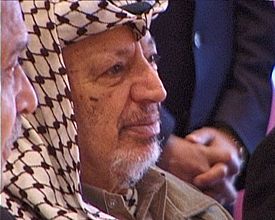
In the Six-Day War of 1967, Israel captured territory including the West Bank, and in November, 1967, UN Security Council Resolution 242 was unanimously adopted, calling for "the establishment of a just and lasting peace" to be achieved by: "Withdrawal of Israeli armed forces from territories occupied in the recent conflict" and: "Termination of all claims or states of belligerency" and respect for the right of every state in the area to live in peace within secure and recognized boundaries. Egypt, Jordan, Israel and Lebanon entered into consultations with the UN Special representative over the implementation of 242.
The Israel-Egypt Peace Treaty of March, 1979, Included an agreement to lend autonomy to Palestinians across the Green Line.
A Palestinian uprising called the Intifadah began in 1987. Palestinians threw rocks at Israeli soldiers occupying the Gaza Strip and the West Bank. Israelis retaliated, and the violence escalated, resulting in hundreds of deaths.
In 1988, Jordan ceded its claims to the West Bank to the Palestine Liberation Organization, as "the sole legitimate representative of the Palestinian people."
During the 1991 Gulf War, Iraq hit Israel with 39 Scud missiles. During the war, Israel provided gas masks for the Palestinians in the West Bank and Gaza. The PLO, however, supported Saddam Hussein. Palestinians in the West Bank and Gaza marched and famously stood on their rooftops while Scud missiles were falling and cheered Saddam Hussein, calling for him to bomb Israel with chemical weapons. Palestinians also used the gas masks against Israeli tear gas in the coming years.
The 1993 Oslo Accords declared the final status of the West Bank to be subject to a forthcoming settlement between Israel and the Palestinian leadership. Following these interim accords, Israel withdrew its military rule from some parts of West Bank, which was then split into:
- Palestinian-controlled, Palestinian-administered land (Area A)
- Israeli-controlled, but Palestinian-administered land (Area B)
- Israeli-controlled, Israeli-administered land (Area C)
Areas B and C constitute the majority of the territory, comprising the rural areas and the Jordan River valley region, while urban areas â where the majority of the Palestinian population resides â are mostly designated Area A. Israel continued to maintain overall control over Israeli settlements, roads, water, airspace, "external" security and borders for the entire territory.
On November 4, 1995, a Jewish nationalist militant named Yigal Amir assassinated Israel's prime minister Yitzhak Rabin. Likudâs Benjamin Netanyahu, elected prime minister in 1996, withdrew from Hebron and signed the Wye River Memorandum, giving wider control to the Palestinian National Authority.
Israelâs prime minister Ehud Barak and Palestine Liberation Organization leader Yasser Arafat conducted negotiations with U.S. President Bill Clinton at the July 2000 Camp David summit. Barak offered to form a Palestinian State initially on 73 percent of the West Bank and 100 percent of the Gaza Strip. In 10 to 25 years, the West Bank area would expand to 90 percent (94 percent excluding greater Jerusalem). Arafat rejected this deal.
After the collapse of the talks, Palestinians began a second uprising, known as the Al-Aqsa Intifadah, just after the leader of the opposition, Ariel Sharon, visited the Temple Mount in Jerusalem.
In 2003, the Israeli government began building the West Bank barrier, a network of fences with vehicle-barrier trenches surrounded by a 200-foot (60-meter) wide exclusion area (90 percent) and up to 26-foot (eight-meter) high concrete walls (10 percent).
It is located mainly within the West Bank, partly along the 1949 Armistice line, or Green Line, between the West Bank and Israel. As of April 2006 the length of the barrier as approved by the Israeli government was 436 miles (703km) long. Approximately 58.4 percent had been constructed, 8.96 percent was under construction, and construction had not begun on 33 percent of the barrier.
Government and politics
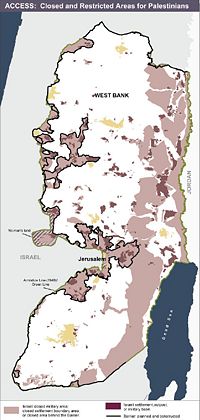
The Oslo Accords signed in 1993 by Israel and the Palestine Liberation Organization, established the Palestinian National Authority in 1994, a governing body for the West Bank and the Gaza Strip as a five-year transitional body during which final status negotiations between the two parties were to take place.
The Palestinian authority is distinct from the Palestine Liberation Organization, and it is the PLO, not the PNA, which enjoys international recognition as the organization representing the Palestinian people. The Palestinian people living outside the West Bank and Gaza, which constitutes the majority of the Palestinian people, are not allowed to vote in elections for PNA offices. Under the name "Palestine," it has an observer status in the United Nations since 1974. After the 1988 Palestinian Declaration of Independence, the PLO's representation at the United Nations was renamed Palestine. It is the PLO, not the PNA, which has participated in General Assembly debates, without voting, since 1998, and which was recognized by Israel as the sole legitimate representative of the Palestinian People in the negotiations leading to the Oslo Accords.
The PNA previously received considerable financial assistance from the European Union and the United States (approximately $1-billion combined in 2005), but both suspended all direct aid on April 7, 2006, as a result of the Hamas victory in parliamentary elections.
Political structure
The President of the Palestinian National Authority is the highest-ranking political position (equivalent to head of state) in the Palestinian National Authority (PNA). The president is elected by popular elections.
The prime minister is appointed by the president and thus not directly elected by the Palestinian Legislative Council (parliament) or Palestinian voters. Unlike the prime minister's office in many other nations, the Palestinian Prime Minister does not serve as a member of the legislature while in office. Instead, the appointment is made independently by the ruling party. The prime minister is expected to represent the majority party or ruling coalition in the parliament.
Palestine's national legislature is called the Palestinian legislative council (Majlis al-Tashri'i in Arabic). The legislative council passed a new law in June 2005 increasing the number of MPs from 88 to 132, stipulating that half be elected under a system of proportional representation and half by traditional constituencies. New parliamentary elections took place on January 25, 2006. Militant Islamic party Hamas took 74 of the 132 seats.
The constitution calls for an independent judiciary branch, and for the establishment of a Supreme Judicial Council.
Status
Jordan governed the West Bank from 1950 until it was occupied by Israel in the Six-Day War of 1967. During that war, Israel occupied the West Bank and established a military administration through the area, excluding East Jerusalem, to which Israel extended Israeli citizenship, law, and civil administration. For ten years there was little resistance to Israeli rule, during which time Israel increased electrification and improved housing and health care in the area.
Between 1979 and 1983, while Menachem Begin was prime minister, the number of Israeli settlements more than tripled, and the number of Israeli settlers increased more than fivefold. The increase was part of a defense strategy and to extend its agricultural economy. Land, businesses, and buildings were taken from Arab inhabitants, many of whom were long gone. Israel claimed a right to administer land in the West Bank not cultivated or privately owned, which could amount to between 30 and 70 percent of the West Bank. This claim gave rise to suspicions that Israel intended ultimately to annex the area piecemeal.
Anti-Israeli rioting broke out among the Arab and Palestinian residents of the West Bank in December 1987 and became a permanent feature of West Bank life.
Israel and the PLO agreed in September, 1993, on a plan to gradually extend self-government to the Palestinians of the West Bank (and Gaza Strip) over a five-year period prior to a final settlement of the issue of Palestinian statehood. Implementation began in May 1994 when the Israelis withdrew from Jericho.
The future status of the West Bank, together with the Gaza Strip on the Mediterranean shore, has been the subject of negotiation between the Palestinians and Israelis, although the Road Map for Peace, proposed by the "Quartet on the Middle East" comprising the United States, Russia, the European Union, and the United Nations, envisions an independent Palestinian state in these territories living side by side with Israel.
The Palestinian people and the United Nations call the West Bank and Gaza Strip "Israeli-occupied," and the United States generally agrees. Many Israelis and their supporters prefer the term "disputed territories," claiming it comes closer to a neutral point of view. Israel argues that its presence is justified because: Israel's eastern border has never been defined, the "disputed territories" have not been part of any state, and according to the Camp David Accords (1978) with Egypt, the 1994 agreement with Jordan and the Oslo Accords with the PLO, the final status of the territories would be fixed only when there was a permanent agreement between Israel and the Palestinians.
Palestinian public opinion is almost unanimous in opposing Israeli military and settler presence on the West Bank as a violation of their right to statehood and sovereignty.
Israeli opinion is split into a number of views:
- Complete or partial withdrawal from the West Bank in hopes of peaceful coexistence in separate states (sometimes called the "land for peace" position). A 2003 poll shows that 76 percent of Israelis support an agreement based on that principle.
- Maintenance of a military presence in the West Bank to reduce Palestinian terrorism by deterrence or by armed intervention, while relinquishing some degree of political control.
- Annexation of the West Bank while considering the Palestinian population as (for instance) citizens of Jordan with Israeli residence permit as per the Elon Peace Plan.
- Annexation of the West Bank and assimilation of the Palestinian population to fully fledged Israeli citizens.
- Annexation of the West Bank.
- Transfer of the East Jerusalem Palestinian population. A 2002 poll at the height of the Al Aqsa intifada found 46 percent of Israelis favoring Palestinian transfer of Jerusalem residents.
Annexation
Israel annexed the territory of East Jerusalem, and its Palestinian residents (if they should decline Israeli citizenship) have legal permanent residency status. Although permanent residents are permitted, if they wish, to receive Israeli citizenship if they meet certain conditions including swearing allegiance to the State and renouncing any other citizenship, most Palestinians did not apply for Israeli citizenship for political reasons.
There are various possible reasons as to why the West Bank had not been annexed to Israel after its capture in 1967. The government of Israel has not formally confirmed an official reason, although possible reasons could be:
- Reluctance to award its citizenship to an overwhelming number of a potentially hostile population whose allies were sworn to the destruction of Israel.
- Fear that the population of non-Zionist Arabs would outnumber the Israelis, appeal to different political interests, and vote Israel out of existence; thus failing to maintain the concept and safety of a Jewish state.
- To ultimately exchange the land for peace with neighboring states.
Legality of settlements
Israeli settlements on the West Bank beyond the Green Line border are considered by some legal scholars to be illegal under international law. Other legal scholars have argued that the settlements are legal, on a number of different grounds.
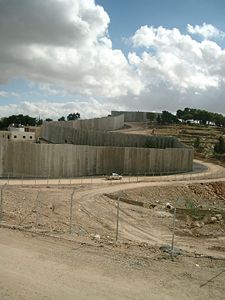
The Independent reported in March 2006 that immediately after the 1967 war Theodor Meron, legal counsel of Israel's Foreign Ministry advised Israeli ministers in a "top secret" memo that any policy of building settlements across occupied territories violated international law and would "contravene the explicit provisions of the Fourth Geneva Convention."
A contrasting opinion was held by Eugene Rostow, a former Dean of the Yale Law School and undersecretary of state for political affairs in the administration of U.S. President Lyndon Johnson, who wrote in 1991 that Israel has a right to have settlements in the West Bank under 1967's UN Security Council Resolution 242.
It is the policy of both Israel and the United States that the settlements do not violate international law, although the United States considers ongoing settlement activity to be "unhelpful" to the peace process. The European Union and the Arab League consider the settlements to be illegal. Israel also recognizes that some small settlements are "illegal" in the sense of being in violation of Israeli law. In 2005 the United States ambassador to Israel, Dan Kurtzer, expressed U.S. support "for the retention by Israel of major Israeli population centers (in the West Bank) as an outcome of negotiations,â reflecting President Bush's statement a year earlier that a permanent peace treaty would have to reflect "demographic realities" on the West Bank.
The UN Security Council has issued several non-binding resolutions addressing the issue of the settlements. Typical of these is UN Security Council resolution 446 which states "[the] practices of Israel in establishing settlements in the Palestinian and other Arab territories occupied since 1967 have no legal validity," and it calls on Israel "as the occupying Power, to abide scrupulously by the 1949 Fourth Geneva Convention."
West Bank barrier
The barrier is a controversial project. Supporters claim the barrier is necessary to protect Israeli civilians from Palestinian terrorism, including suicide bombing attacks, which increased significantly during the al-Aqsa Intifada. Its supporters claim that the onus is now on the Palestinian Authority to fight terrorism.
Opponents claim the barrier is an illegal attempt to annex Palestinian land under the guise of security, and severely restricts Palestinians who live nearby, particularly their ability to travel freely within the West Bank and to access work in Israel, thereby undermining their economy.
Pro-settler opponents claim that the barrier is a sly attempt to artificially create a border that excludes the settlers, creating "facts on the ground" that justify the mass dismantlement of hundreds of settlements and displacement of over 100,000 Jews from the land they claim as their biblical homeland.
Factions
Hamas or "Harakat al-Muqawama al-Islamiyya" or "Islamic Resistance Movement"; the Arabic acronym means "zeal") is a Palestinian Islamist organization that since January 2006 forms the majority party of the Palestinian National Authority. Created in 1987 by Sheikh Ahmed Yassin of the Gaza wing of the Muslim Brotherhood at the beginning of the First Intifada, in 1987, Hamas is best known outside the Palestinian territories for its suicide bombings.
Fatah, a reverse acronym from the Arabic name "Harakat al-Tahrir al-Watani al-Filastini" (literally: "Palestinian National Liberation Movement") is a major secular Palestinian political party and the largest organization in the Palestine Liberation Organization (PLO), a generally secular multi-party confederation. In Palestinian politics it is on the center-left of the spectrum. It is mainly secular and nationalist although not predominantly socialist. Fatah has maintained a number of militant groups since its founding.
The movement, which espoused a Palestinian nationalist ideology in which Palestine would be liberated by the actions of Palestinian Arabs, was founded in 1958 or 1959 by members of the Palestinian diaspora - principally professionals working in the Gulf States who had been refugees in Gaza and had gone on to study in Cairo. Yasser Arafat was head of the Palestinian student movement in Cairo from 1952 to 1956. Fatah became the dominant force in Palestinian politics after the 1967 Six-Day War dealt the coup de grâce to the Arab nationalism that had inspired George Habash's Arab Nationalist Movement.
The Popular Front for the Liberation of Palestine (PFLP) (Arabic: al-Jabhah al-Sha`biyyah li-Tahrīr Filastīn) is a Marxist-Leninist, nationalist Palestinian political and military organization, founded in 1967. It has consistently been the second-largest of the groups forming the Palestinian Liberation Organization (the largest being Fatah). It has generally taken a hard line on Palestinian national aspirations, opposing the more moderate stance of Fatah. It opposed the Oslo Accords and was for a long time opposed to the idea of a two-state solution to the Israeli-Palestinian conflict, but in 1999 came to an agreement with the PLO leadership regarding negotiations with Israel. It has been designated as a terrorist organization by the United States, the European Union, and Israel.
The Democratic Front for the Liberation of Palestine (DFLP) (Arabic Al-Jabha al-Dimuqratiya Li-Tahrir Filastin) is a Palestinian Marxist-Leninist political and military organization. It is also frequently referred to as the "Democratic Front," or "al-Jabha al-Dimuqratiyah" (اÙجبÙØ© اÙدÙÙ ÙÙراطÙØ©). It is a member organization of the Palestine Liberation Organization.
The Palestinian People's Party (PPP, in Arabic "Hizb al-Sha'b al-Filastini), founded in 1982 as the "Palestinian Communist Party," is a socialist political party in the Palestinian territories and among the Palestinian diaspora.
The Palestine Democratic Union ("Al-Ittihad al-Dimuqrati al-Filastini," generally known as FIDA) is a small Palestinian political party active in the Palestinian Liberation Organization (PLO) and the Palestinian National Authority (PNA).
Economy
The West Bank, the larger of the two areas under the Palestinian Authority, has undergone a sharp economic decline since the second intifadah began in September 2000. The increased violence and Israeli checkpoint closures associated with the conflict caused a recession in 2001-2002. The World Bank compared this recession to the Great Depression of 1929. Loss of international aid after Hamas won legislative control of the Palestinian Authority, worsened financial problems.
As of December 2006, unemployment in the West Bank and the Gaza Strip has risen from 23 percent in 2005 to over 50 percent. Two-thirds of Palestinians are living below the poverty line. In the last four months of 2006, approximately 10,000 emigrated, and approximately 50,000 have applied to do so. For the last nine months of that year, the 160,000 civil service workers, who were the primary breadwinners for a third of households, have not received their full salaries due to the cuts in foreign aid.
The West Bank has 2,800 miles (4500km) of roads, of which 1680 miles (2700km) are paved. In response to shootings by Palestinians, some highways, especially those leading to Israeli settlements, are completely inaccessible to cars with Palestinian license plates, while many other roads are restricted only to public transportation and to Palestinians who have special permits from Israeli authorities. Israel maintains more than 50 checkpoints in the West Bank.
The West Bank has three paved airports which are for military use only. The only civilian airport of Atarot Airport in northern Jerusalem, which was open only to Israeli citizens was closed in 2001 due to the Intifada.
The Israeli Bezeq and Palestinian PalTel telecommunication companies provide communication services in the West Bank. The Palestinian Broadcasting Corporation broadcasts from an AM station in Ramallah. Most Palestinian households have a radio and TV, and satellite dishes for receiving international coverage are widespread. PalTel has begun implementing an initiative to provide ADSL broadband internet service to all households and businesses.
Exports (including Gaza Strip) totaled $301-million in 2005. Export commodities included olives, fruit, vegetables, and limestone. Export partners included Israel, Jordan, and Gaza Strip.
Imports totaled $2.44-billion. Import commodities included food, consumer goods, construction materials. Import partners included Israel, Jordan, and Gaza Strip. Per capita GDP in 2005 (including Gaza Strip) was $1500.
Demographics
The Palestinian Central Bureau of Statistics estimated that approximately 2.5 million Palestinians lived in the West Bank (including Israeli-annexed East Jerusalem) at the end of 2006. But a study by the American-Israel Demographic Research Group suggests that there are 1.4 million Palestinians there, and after that study the Palestinian statistics bureau reduced estimates by more than 700,000. There are some 267,163 Israeli settlers, more than 200,000 in East Jerusalem. There are over 260,000 Israeli settlers living there, as well as around 185,000 Israeli Jews living in Israeli-annexed East Jerusalem. There are also small ethnic groups, such as the Samaritans living in and around Nablus, numbering in the hundreds or low thousands. The Jews in the West Bank live mostly isolated in Israeli settlements with little social interaction with other Palestinians. The population density is fairly high, with over 1095 per square mile (423 people per square kilometer). Life expectancy for the total population was 73.46 years, and more than 40 per cent of the West Bank population is under the age of 15.
Ethnicity
Canaanites are considered to be among the earliest inhabitants of the region today known as Palestine/Israel, Canaan being its earliest known denomination. Some of the Canaanites are believed to have migrated in the third millennium B.C.E. from the inner Arabian Peninsula. However, the Arabization of Palestine and the Palestinians began in Umayyad times (661-750 C.E.).
Advanced genetic surveys have suggested that most of the various Jewish ethnic divisions and the Palestiniansâand in some cases other Levantinesâare genetically closer to each other than the Palestinians to the original Arabs of Arabia or European Jews to non-Jewish Europeans.
In 2007, Palestinian Arabs and others made up 83 percent of the population, while Jewish make up 17 percent.
Religion
Predominantly Sunni Muslim make up 75 percent of the population, 17 percent are Jewish, while Christian and others make up 8 percent. Christian Arabs are concentrated in Bethlehem, Beit Sahour, and RÄm AllÄh. These towns are clustered around Jerusalem, which has a sizable Christian population.
The Islamic holy book, the Qur'an, sets out rules for everyday behavior as well as religious doctrine, so religion, politics, and culture are bound together in Muslim communities. An imam (spiritual leader) delivers a weekly sermon at a mosque on Fridays.
Language
Languages in use are Arabic and Hebrew corresponding to ethnic affiliation; English is widely understood. Arabic is the largest living member of the Semitic language family in terms of speakers. Classified as Central Semitic, it is closely related to Hebrew and Aramaic. In Umayyad times (661-750 C.E.), increasing conversions to Islam among the local population, together with the immigration of Arabs from Arabia and inland Syria, led to the replacement of Aramaic by Arabic as the area's dominant language.
Men and women
Palestinian women are restricted to homemaking or local cottage industries, since many Palestinian men consider it unacceptable for women to work outside the home. Women dress in the traditional Muslim jilbab, a long jacketlike dress, with a scarf to cover the hair. Men are the center of Palestinian life. The family patriarch is the key decision-maker regarding living arrangements, children's marriages, and money. Women must obey their father or husband.
For Israeli settlers, under the Orthodox tradition, women and men live separate lives, women are excluded from many traditional activities, although women are generally accorded equal status to men.
Marriage and the family
For Palestinians, polygamy is common, although most Palestinian men have only one or two wives. When a couple wishes to marry, the man approaches the woman's family. They declare their engagement, and the families get to know one another. This tradition is weaker in urban areas and among university students. A wedding is an occasion for singing, dancing, and feasting. The couple exchanges vows in a Muslim ceremony called the Katb al-Kitab.
The extended family is the strongest social unit, and share the same household. Married children live with their parents. Elderly parents are cared for at home by the families of their children. If a man with several wives can afford a large house, each wife gets her own rooms. But houses tend to be small and lack privacy. Palestinians are proud of their children. An infant boy's circumcision is celebrated. Extended families help in caring for infants and young children. Arab boys and girls are raised separately, and girls are expected to help more with domestic chores.
For Israelis, arranged marriages are uncommon, but there are social taboos against intermarriage, and it is illegal for a Jew to marry a non-Jew. Divorce is legal, but Orthodox Jewish law applies, meaning men have the power to prevent their ex-wives from remarrying. If the woman enters into another relationship, the courts do not recognize it, and any children are considered illegitimate and cannot marry in Israel. The nuclear family is the most common domestic unit, with grandparents sometimes included. The mother takes responsibility for raising the baby, helped by the extended family. Jewish boys are circumcised eight days after birth.
Education
Two main types of schooling are available for Palestinian children. One has a government-directed curriculum, while the other is guided by Islamic principles. Approximately 91.9 per cent of Palestinians aged 14 years and over are literate; 21 per cent of the population has received one to six years of schooling. Christian private schools operate in a number of towns, and the United Nations Relief and Works Agency for Palestinian Refugees in the Near East (UNRWA) operates schools in the refugee camps of the West Bank.
In the last 25 years of the twentieth century, a number of Palestinian institutions of higher learning opened in the West Bank, foremost among them Bir Zeit, Bethlehem, and Al-Najah universities, the Islamic College in Hebron, and the Technical College in Abu Dis.
In total, seven universities have been commissioned in the West Bank since 1967: Bethlehem University, a Roman Catholic institution; Birzeit College; An-Najah National University; the Hebron University; Al-Quds University; the Arab American University; and the Hebrew University of Jerusalem. Most universities in the West Bank have politically active student bodies, and elections of student council officers are normally along party affiliations.
The founding of Palestinian universities has greatly increased West Bank education levels. According to a Birzeit University study, the percentage of Palestinians choosing local universities as opposed to foreign institutions has been steadily increasing; as of 1997, 41 percent of Palestinians with bachelor degrees had obtained them from Palestinian institutions.
Class
Jewish Israeli settlements remain separated from Palestinian communities, and the best roads, shopping centers, jobs, and services tend to be in the Israeli areas. Within the Palestinian community there are two distinct culturesâthe privately educated Palestinians, who lived in the United States or Europe before their parents returned in the mid-1990s, and the majority, who lived through the Israeli occupation. The returnees got the best jobs, and many flaunt money and automobiles. The majority lives in poverty. The gulf between rich and poor may be a bigger problem than attaining Palestinian sovereignty.
Culture
The United Nations definition of a "Palestinian refugee" is a person whose "normal place of residence was Palestine between June 1946 and May 1948, who lost both their homes and means of livelihood as a result of the 1948 Arab-Israeli conflict,â and their descendants, regardless of whether they reside in areas designated as "refugee camps" or in established, permanent communities. The number of refugees who fled or were expelled is controversial; estimates range from under 500,000 to over 950,000. The final UN estimate was 711,000. The West Bank has 699,817 refugees.
Thousands live in refugee camps that have gradually become permanent settlements. The crowded camps comprise small concrete-block huts with corrugated metal doors and roofing. Food is cooked on a metal grate placed over charcoal. Thin mats serve as beds. People bathe and wash clothes in metal drums filled from a community well.
Balata is the largest West Bank camp with a registered refugee population of 21,445. The camp was established in 1950 on land at Nablus. The first West Bank group to defend refugee rights was established in Balata in early 1994. The camp was very active during the intifadah (1987-1993). Many refugees were killed and injured, and numerous shelters were demolished by the Israeli army.
Architecture
Traditional villages comprise single-story houses made of white stone. They have a kitchen, a sitting room, bathing room, and small bedrooms. Many homes have gardens and are enclosed by a high wall with a gate. Wealthier people can have two-story homes, the top used for living quarters and entertaining, the bottom for utilities and storage.
Cuisine
The main meal is eaten between 2pm and 3pm, and may include falafel, sandwiches made with deep-fried balls of garlic- and lemon-flavored chickpea mix, hummus, or grilled lamb sandwiches, called shwarma. Pita bread is a part of every meal. Lamb, eggplant, chicken, and rice are widely eaten, as are baklava pastries, made with honey and almonds or pistachios. Palestinian men drink coffee or tea as a social activity. Mensaf, a large platter of rice covered with a lamb or goat stew and pine nuts, is served at weddings, feasts, and funerals.
Literature
Poet and journalist Mahmoud Darwish is highly political and deals with the Israeli occupation. His poem "Identity Card," written in 1964, is one of the best-known works by a Palestinian. He also composed Palestine's Declaration of Independence. In his anthology The Wind-Driven Reed and Other Poems, (1979) Fouzi al-Asmar evokes the Palestinian longing for a homeland.
Palestinian-American Edward Said, a historian and essayist, explored Palestinians problems and aspirations in Peace and Its Discontents and other books. Other highly regarded émigré writers include Liana Badr and Hassan al-Kanafani.
Fiction writer Ghassan Kanafani, depicts the aimlessness and desperation of Palestinian refugees in short stories in All That Remains: Palestine's Children. The works of many leading Palestinian writers are translated in Salma Khadra Jayyusi's Modern Palestinian Literature.
Music
Palestinian music is one of many regional sub-genres of Arabic music. While it shares much in common with Arabic music, both structurally and instrumentally, there are musical forms and subject matter that are distinctively Palestinian.
Palestinian farmers (fellahin) sang a variety of work songs, while fishing, shepherding, harvesting and making olive oil. Traveling storytellers and musicians called zajaleen were also common, known for their epic tales. Weddings were home to distinctive music, especially the dabke, a complex dance performed by linked groups of dancers. Popular songs were in widely-varying forms, especially meyjana and dalauna.
After the creation of Israel in 1948, the centers for Palestinian music were in the Israeli towns of Nazareth and Haifa, where performers composed in the classical styles of Cairo and Damascus. The shared Palestinian identity first arose during this period, and a new wave of performers emerged with distinctively Palestinian themes, relating to the dreams of statehood.
Late in the 1970s, a new wave of popular Palestinian stars emerged, including Sabreen and Al Ashiqeen. After the 1987 Intifada, a more hard-edged group of performers and songwriters emerged, led by El Funoun, a songwriter.
In the 1990s, Palestinian cultural expression began to stabilize. Wedding bands, having long since disappeared during the fighting, reappeared and played popular Egyptian and Lebanese songs. Tania Nasser soon emerged as a major star, and became well-known for her support of feminism among Palestinian women.
Beginning in the late 1990s, Palestinian youth forged a new Palestinian musical sub-genre - Palestinian rap or hip hop - which blends Arabic melodies and Western beats, with lyrics in Arabic, English and even Hebrew. Young Palestinian musicians tailored the style to express their own grievances.
DAM were pioneers in forging this blend. As Arab citizens of Israel, they rap in Arabic, Hebrew, and English often challenging stereotypes about Palestinians and Arabs head-on in songs like Meen Erhabe? (Who's a terrorist?) Other Palestinian hip hop artists include members of The Philistines, N.O.M.A.D.S, MWR, and the Palestinian Rapperz.
Notes
- â Ramallah is also the location of many foreign representative offices, including that of Canada, Germany, Australia, and South Africa. Gaza currently functions as the administrative capital of the Palestinian National Authority.
- â "Positions on Jerusalem" Wikipedia [1]. accessdate July 13, 2006
- â Gaza City, Municipality of Gaza. Retrieved May 20, 2007.
- â Encyclopædia Britannica 2007. West Bank, Encyclopædia Britannica Online.
ReferencesISBN links support NWE through referral fees
- Albin, Cecilia. 2001. Justice and fairness in international negotiation. Cambridge studies in international relations, 74. Cambridge [England]: Cambridge University Press. ISBN 0521793289
- Bamberger, David. 1985. A young person's history of Israel. New York, NY: Behrman House. ISBN 0874413931
- Gibney, Mark and Frankowski, Stanislaw (1999). Judicial Protection of Human Rights. Praeger/Greenwood. ISBN 0275960110
- Playfair, Emma, Ed. 1992. International Law and the Administration of Occupied Territories. Oxford University Press. ISBN 0198252978
- Hoyland, Robert G. 2001. Arabia and the Arabs: from the Bronze Age to the coming of Islam. London; New York: Routledge. ISBN 0415195349
External links
All links retrieved May 4, 2023.
- Israel and Palestinian Territories BBC News Country Profile.
Credits
New World Encyclopedia writers and editors rewrote and completed the Wikipedia article in accordance with New World Encyclopedia standards. This article abides by terms of the Creative Commons CC-by-sa 3.0 License (CC-by-sa), which may be used and disseminated with proper attribution. Credit is due under the terms of this license that can reference both the New World Encyclopedia contributors and the selfless volunteer contributors of the Wikimedia Foundation. To cite this article click here for a list of acceptable citing formats.The history of earlier contributions by wikipedians is accessible to researchers here:
- West_Bank history
- Political_status_of_the_West_Bank_and_Gaza_Strip history
- Palestinian_people history
- Israeli_West_Bank_barrier history
- Politics_of_the_Palestinian_National_Authority history
- Economy_of_the_Palestinian_territories history
- Demographics_of_the_Palestinian_territories history
- Palestinian_refugee history
- Hamas history
- Fatah history
- Democratic_Front_for_the_Liberation_of_Palestine history
- Palestinian_People's_Party history
The history of this article since it was imported to New World Encyclopedia:
Note: Some restrictions may apply to use of individual images which are separately licensed.

